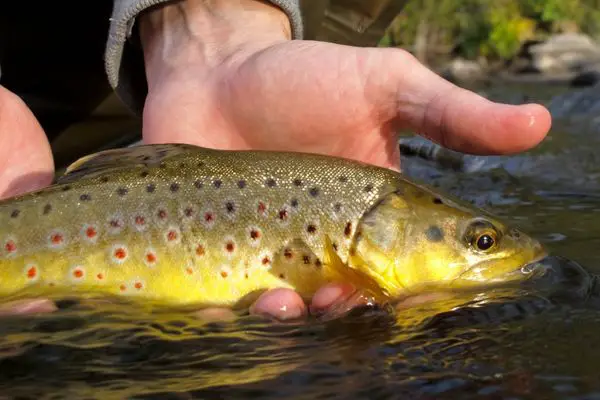When many people think of brown trout, we assume they are native to Europe. While this is true, the species has naturally dispersed over a much greater area than just Europe. Isolated populations also exist in North-West Africa, Central Asia, and Iceland. Iceland straddles the North American and Eurasian plates.
One easy way to define the range of the brown trout is through temperate rivers drainage basins. Native brown trout can be found in rivers that flow into the following significant bodies of water. European Atlantic, North, Baltic, Mediterranean, and Black seas.
Significant populations have also become established in the river basins surrounding the landlocked Caspian and Aral Seas. I will later explain how they got there.
In Russia, brown trout do not occur east of the Ural Mountains.
What is a brown trout?
When most people think of brown trout, we think of Salmo trutta, sometimes known as the Atlantic brown trout, its natural range is Northern Europe, this includes the trout of German and British stock that was introduced into the New World.
But Salmo trutta is just the tip of the iceberg, there are many more species of brown trout.
In southern Europe, North Africa, and the ‘east’, the species of brown trout are very diverse, and the line between species and subspecies is too complicated to attempt to explain or even classify with any high degree of certainty. Let’s just say, there are dozens of brown trout species. The most well-known one being the marble trout.
To simplify matters, I will include the entire ‘brown trout species complex’ no matter whether the trout are classified as a different species or subspecies from S. trutta.
I will do my best to exclude populations classified as Salmon (E.g. Salmo salar, Salmo carpio, Salmo ciscaucasicus). I will note, that Salmo salar, the Atlantic salmon, is very closely related to brown trout and is native to the North-East of North America.
With that said, the distribution of Salmon belonging to the Salmo Genus is broadly the same as the distribution of trout. The main exception is that the Salmon have been able to spread further west into Greenland and North America.
Brown trout in Europe:
Brown trout are native throughout Europe, it will be easier to list the countries that do not have brown trout than the ones that do. They are very widespread.
The only countries in Europe that do not have Brown trout are island nations such as Malta and Cyprus or city states such as the Vatican.
Greenland also does not have brown trout, although while the Island is within the Danish sphere of influence the entire island of Greenland is technically in North America. Although Greenland does have Atlantic salmon.
In southern Europe, where the climate is hotter and more arid, brown trout are primarily found in isolated mountain valleys where the water is cooler.
In northern Europe, the range of the brown trout extends well into the artic circle.
How far east in Russia do brown trout live?
Brown trout and other Salmo species are common throughout European Russia as far east as the Urals mountains. Beyond the Urals, in Siberia there are no native Salmo species. They are replaced by Asianic trout such as the Lenok(1) or taimen . I know of no records of brown trout and lenoks sharing a catchment.
In southern Russia, The Caspian sea, and many of the tributaries are home to two species of Salmo, the Caspian salmon, and the Caspian trout. They use to be quite widespread, running the tributaries, but now populations are rare.
Brown trout in Central Asia
In central Asia brown trout are mostly restricted to deep lakes or isolated mountain valleys. There are various species, subspecies and morphs found throughout this region.
Aral Sea species of brown trout
The range of brown trout in central Asia is dominated by the Aral Sea. Before being destroyed by soviet water mismanagement, the Aral Sea was home to several species of Salmo, from there they populated many of the headwater tributaries throughout the stans.
Are brown trout native to Afghanistan?
The south-easternmost natural distribution of brown trout occurs in the northernmost watershed of Afghanistan. There, a subspecies of brown trout known as the Amu-Darya trout which survives in the upper reaches of the river system with the same name. The Amu-Darya River once flowed unimpeded to the Aral Sea. (1)
There is also a species of fish called the snow trout that inhabits the mountain streams of central Asia. Despite the name, they are not trout.
Trout in Tajikistan
Similar situation as Afghanistan, populations of Amu-Darya trout survive in the Kekemeren river and tributaries. Although, the exact distribution of native trout is difficult to track due to the introduction of stock brown trout from other regions(1).
Kyrgyzstan
Finding information regarding native trout distribution in Kyrgyzstan is not enjoyable. Finding reliable information from the stans is never fun, but Kyrgyzstan is extra difficult because native trout are extremely rare, and any such populations have likely been diluted by introduced populations of Amu-Darya trout before any records of native populations were kept. (1).
Nowadays, without intensive genetic testing separating them is nearly impossible. The only record of native trout in Kyrgyztan was from the 1870’s when Amu-Darya trout were recorded in the Darmut stream, a tributary of the Kyzylsu River. (I spent way too long searching and was never able to locate the Darmut on a map, it is probably known by different spelling)
Trout in Uzbekistan
Trout are now considered extinct in Uzbekistan, historically they probably would have migrated through Uzbekistan to their spawning grounds in mountain streams.
Caspian sea trout
The Caspian sea is home to several species of trout and salmon. Depending on who you asked they are considered to be species, subspecies, or just morphs of Salmo trutta.
From the Caspian Sea brown trout have spread out into the bordering states including Iran, Azerbaijan, and potentially Turkmenistan. Migratory sea-run populations are low, but river populations seem to be doing well.
How did Brown trout colonize landlocked inland seas?
While researching for this article, one question kept distracting me. How did brown trout make it into the Caspian, Aral and other landlocked seas and lakes of central Asia?
Well, I could not find a published answer anywhere, but I kept digging and finally come up with an answer that answered my curiosity. So according to my readings, this is a probable answer.
I suspect the brown trout colonized these inland seas sometime between 11 and 5.3 million years ago. During this time period, the entire area was part of a mega-lake which historically was part of the Paratethys sea.
The “Parathethsys lake” was occasionally connected to the Mediterranean, which would have allowed trout to colonize the lake and surrounding tributaries.
Both brown trout and Atlantic salmon have been around for some 10 million years(1), which means both species would have been present to colonize the Parathethsys.
Brown trout in the Middle East.
Turkey contains quite a few trout in streams that drain not only into the Mediterranean but also the Black and Caspian Seas.
The most interesting, and unusual of the Turkish trout occur in the headwaters of the Tigris and Euphrates rivers (1), anyone interested in geology might know that this major river system flows through Iraq and drains into the Persian Gulf.
Yes, while not unheard of, somehow Turkish brown trout were able to cross a Mountain Range between catchments.
Lebanon – Middle East most southern trout.
Trout are native to Lebanon, being Indigenous to the Asi River in North Bekaa. This area is located north of the capital Beirut.
Staying in the Middle East, native brown trout no longer exist in Israel or Jordan. Although trout bones have been found in the Jordan valley, but they likely went extinct with the warming of the climate following the last glacial maximum. (1)
Northern Africa – Morrocco is home to the only African trout
Remnant, yet endangered populations of native brown trout survive in the cold streams and lakes of the Atlas mountains in Morocco.
These include an unexpected population of trout that live in the headwaters of the River Ziz that drains into the Sahara Desert. This is another example of brown trout jumping mountain ranges into catchments that drain into a different sea.
Brown trout were always once found in Algeria, with populations isolated to a handful of rivers along the coast. These natural populations are now facing extinction due to displacement by the stocking of hatchery fish of different lineages.


Very interesting. I’ve been studying Native trout four 40 years. One of my favorites is the Native Masu, from the mountains of Taiwan 🇹🇼.
Leif
Thank you for the comment. I have read quite a bit about the native trout in Taiwan. They are apparently the only trout that naturally occur in a sub-tropical part of the world. They have been living there, trapped in their mountain streams since the last ice age. Cherry/Masu trout are fascinating, if little known outside of East Asia.